We often labour under the apprehension that if people had seen what we have seen then they would see those things the way we do. This may or may not be true. It may be true in some instances but not in others. It may be that for some people certain information would only have an effect if it was validated by a supposed authority such as the BBC, the government, or some other paternalistic figure or organisation. It may be that some people think with their emotions and not with their rationale. It may be that some people could never accept some information as to do so would be too much of an emotional challenge. It may be that some people do not think.
The information about the dangers of the fake vaccines is increasingly available and widely known but there are still people dispensing and accepting them. Some people still wear masks and excuse lockdowns, propagandists, and politicians, including the 'father of the vaccine.' The state openly admits its inability to go to the moon and yet there are those who believe that mankind is set to build a city on Mars, which is said to be (the freemasonic number of) 33 million miles away when at its closest to earth.
In our perceptions and discussions of subjects to which we have a more neutral attitude we tend to agree that certain behaviour is sufficiently unusual as to provoke suspicion. A common understanding of what constitutes, 'suspicious behaviour,' or, 'acting suspiciously,' is suggested by the existence of those phrases. One example of this is of Diane Downes, the mother who smirked when telling the story of her murdered children.
We accept that people don't tend to smirk at the loss (or even at the injury or endangerment) of their children or loved ones. People don't usually have miraculous recoveries from injuries such as those sustained in shootings or bombings. Following treatment we would expect people to be aware of how many times they got shot. This is the usual consensus until incidents of this nature are encountered in the context of terror inducing events that serve state agendas. Then all manner of excuses are proferred to explain anomalous behaviour in order to avoid the unwelcome implication it provokes -that of the possibility of deceit, or acting. It is argued that people are all different, that we all respond differently to grief, to being on camera, or to being questioned. Some people enjoy the limelight. Some people laugh nervously and make mistakes, but it is also true that other people will laugh as they lie in our faces.
In the years since 9/11 there have been a number of incidents similar to the Manchester Arena event in which the incident itself has been questionable and the alleged perpetrators had links to the authorities. The authenticity of the victims and others involved were contemporaneously questioned by the online dissident community. We all understand the difference between evidence and speculation and though examining the evidence for each event is beyond the scope of this essay summaries of terrorist events in 2015 and 2016 have been made by the ever empirical Kevin Ryan and I have included further links regarding other events in Part 1 and throughout this series.
The preposterous footage of Nick Bickerstaff at the Manchester Arena that is suggestive of both foreknowledge and hammy acting is one in a long line of such performances with which consumers of mass media have been presented.
Here we are going to examine a selection of these characters. I will provide a brief precis of each one but as with the Bickerstaff footage they have to be seen to be disbelieved.
On the evening of December 15th 2012, the day after his six year old daughter had been killed in the Sandy Hook school shooting, Robbie Parker delivered a statement to the media which he began, apparently unaware that he was on air, relaxed, jocular, and grinning before taking deep breaths and delivering his statement of grief. When I showed this to an actor many years ago their surprised reaction was that it looked like an actor getting into character. This unusual behaviour was aired live but was absent from subsequent mainstream media reports.
When questioned in his moment of grief, Parker made two references to a quickly established on line fundraiser. When asked about his attitude towards the shooter he entered into a discourse on free will saying, “I'm not mad…because I have my agency to use this event to do what I can, to do whatever I can, to make sure that my family, my wife, and my daughters are taken care of.”
The event he refers to using is the shooting to death of his daughter.
The following day, appropriately named pathologist Dr. Carver, gave a press conference in which he seemed ignorant both of the seriousness of the event and of anything he was asked about it. His demeanour was erratic, alternating between serious, mirthful, and bizarre, all of which was to the seeming amusement of watching policemen. He claimed to have been doing the job for a third of century, invoking the number 33.
His performance provoked the following questions from Anonymous User who uploaded it to youtube.
Why is Dr. H. Wayne Carver, the Chief Medical Examiner for the Sandy Hook Elementary School shootings, snickering throughout the entire course of this Press Conference? Why does he answer certain questions in a terse and impatient manner? Why do his mannerisms appear to be so strange? And why is he unable to answer even the most basic questions regarding the parameters of this case?
@ComfortBlades commented, “I don't think I've ever seen such a strong consensus in a comment section on youtube before. This guy was floundering from moment one.”
@VperVendetta1992 commented, “If this isn't an actor, it's the worst medical examiner the world has ever seen.”
Similar incredulity seemed to be written on the face of news anchor Nancy Grace in response to the tone of the account given by witness Gene Rosen of his encounter with distressed school children who escaped the shooting.
Rosen finishes by telling Grace, “Nancy, I want to be with these children. I want to read to them. I want to show them there's light away from the darkness. I want to be their Granpy, their Uncle Gene, whoever. I want to spend time with them, as much as they will allow and their parents will allow. I want them to come to my home I just want to love them because they were very brave and very sweet and and their innocence has been torn away. I know it'll take time. I want to be related to them for the rest of my life. That's my goal that's my purpose and that's my prayer.”
Rosen’s bizarre account was given several different airings. Rosen was also filmed seemingly practising his lines for a report.
A few days after the incident at Sandy Hook the parents of murdered seven year old Grace McDonnell invited suspected CIA media operative Anderson Cooper into their home to share with him and the rest of the world, their unusually cheery grief. Cooper ended the report by showing the audience a painting of an owl made by the deceased child.
“The owl is thought to symbolize knowledge, insight, and the ability to see that which others cannot,” which is why a 40 foot statue of one features at Bohemian Grove, where the world’s misleaders meet for occult ceremonies and planning.
The siblings of heroic, photogenic, murdered young teacher, Vicky Soto, were also in notably good spirits, even only days after her death. Whether speaking of her love for her pupils, her last words, her memory being honored by Obama, or advocating for gun control on television with Piers Morgan, they remembered her with smiles.
Similar amusement flashes over the faces of Robbie Parker and his wife Alissa, when some time later they were asked of the loss of their three year old daughter Emilie, “What has this past six months been like for you?” Alissa described coping with the loss of her daughter by blogging, provoking critical comments for her mannerisms and choice of words. Robbie (obscured in picture) and a smiling Alissa enjoyed the visit of President Obama two days after the massacre.
Elsewhere, outlandish joviality was evident on the face of Kate Foley when she spoke of her brother, James Foley, “an American journalist and video reporter who was killed by ISIS in Syria in 2014.”
Of the quirks of the Foley case, I commented at the time,
“The 'execution' footage was accepted by the mainstream media and the FBI but after the internet picked over it for a week, major British and US media outlets declared that anonymous experts had found the footage to be fake. This left two alternative explanations:
1. ISIS elaborately staged an execution it actually committed- which seems odd.
Or 2. ISIS (or someone else) staged an execution that was never committed.
This second equally plausible possibility never dawned on the British media. It was accepted that Foley had been executed despite the fake footage. The response was a call for military action, especially in Syria.”
There is a photograph of the beheaded James Foley which I will include at the bottom of this article. That this footage was officially found to be faked gives some indication of what is possible. As we have seen, crisis agencies can provide extremely realistic and gory special effects.
Anderson Cooper featured again (on June 15th, 2016) when he interviewed the beaming Christine Leinonen three nights after she had lost her son in the Orlando nightclub shooting. The slaughter was reportedly committed by registered actor and son of CIA agent, Omar Mateen, who worked for security company G4S and also had interaction with the FBI and NYPD. More people were reported to have died in the Orlando shooting than in any other terrorist event on US soil, other than 9/11. A day later the authorities allowed the media to casually walk around the crime scene of Mateen’s apartment.
On the morning after the shooting, before she knew whether her son was dead or alive the tearless Leinonen ended a television interview with a plea for increased gun control. Leinonen had previously submitted a video audition for the television show wheel of fortune, presumably seeking either fame or fortune or both. With Cooper she exhibited the smiling demeanour that seems to be typical of a parent who has lost a child in an incident that serves a state agenda. So excessively happy did she appear during her fifteen minutes of fame that Cooper was forced to comment on it, questioning her as to where she found her strength. This contentment contrasted starkly with her wailing of a few days earlier when it was still possible that her son was alive. Leinonen tells Cooper that her son was, “Orlando’s child. Even though I gave birth to him Orlando is now the adoptive mother.”
We could also wonder where others involved in the Orlando shooting found their strength. Actor Luis Burbano gave an account of one victim being unaware of a bullet as long as a finger sticking out of their arm. It seems unlikely that a bullet fired from an AR-15 would fail to penetrate an arm, or that someone shot by an AR-15 would be unaware of it, and in any event, it is not possible that the bullet would be as long as a finger. Including its casing an AR-15 round is only 2.26 inches (5.74cm) long and only the half inch (1.27cm) long upper section becomes a projectile when it is fired.
The dart-like effect Burbano claims of the bullet contrasts with the injury suffered by another victim he described as having, “lost half his arm,” in the same shooting.
Amazing strength was also demonstrated by Norman Casiano who, "claimed that he had been shot four times in the back, and that each bullet had gone "all the way through." Later, he said that he had been shot twice in the back. Any bullet that enters the chest will cause the lung to collapse, and the patient will not survive, unless he is placed on a chest tube to continuous suction for several days. Any bullet that enters the abdomen will perforate the intestines, which will require open surgery to repair, and a hospital stay of at least several days. Norman Casiano said that he spent two days in the hospital, yet he was out of the hospital, looking fit as a fiddle, the day after the Orlando Pulse shooting incident, for his interview with Anderson Cooper."
A man wearing red shoes demonstrated similar powers of recovery as he was carried past TV cameras seemingly, judging from the blood and tourniquet on his jeans, having been shot in the leg. Apparently thinking themselves out of camera shot, his bearers then set him down and he then stood easily and playfully pushed one of them as though involved in an enjoyable activity and not a horrific massacre. This was aired live but edited out of subsequent broadcasts of the event. As with many such potentially incriminating pieces of footage, it is not now easy to find. Even the internet archive is now censored of many videos and web pages. This scene evokes comparison with the footage of Ruth Murrell walking at the Manchester arena despite a bolt passing through her leg.
The scene was part of a parade of apparent victims of the shooting being taken not from, but back towards the Pulse nightclub. This procession was notable for the lack of distress exhibited or communicated by those involved, to the filming media. Prominent in this footage was actor Christopher Hansen who performed a series of interviews outside the nightclub that night and the following day dressed in a shirt with a large American flag design.
He later appeared displaying a rainbow flag on his hat.
One man who was not accomplished in front of an audience was Adam Moss whose account of his experience at Pulse nightclub led people to describe him as, “a terrible,” and “maybe the worst ever,” crisis actor (in what appears to be a field of stiff competition). Whilst being interviewed he was apparently being prompted by his companion to whom he said ‘shush,’ when she befuddled him by asking the height of his missing friend, Christopher Summers. When asked if he had a message for Summers he said, “No bullet could ever break a friendship.”
At the Pulse nightclub, Norman Casiano was shot four times, Tony Sanchez was shot four times and Angel Colon was shot six times. They were all giving interviews within a couple of days with no significant signs of physical or emotional trauma.
Similar fortitude and good fortune was enjoyed by Rome Shubert during a school shooting in Texas in 2018, when he was shot in the head, did not notice his injury, ran away, scaled a 7 foot wall, required only an hour in hospital and a bandaid and then played baseball the next day. We are told the truth is stranger than fiction but sometimes both eventualities seem equally strange.
Shubert’s exit wound is pictured below.
Marcus Weaver was shot in the arm in the Aurora shooting in 2012, and had it placed in a cast, but this did not inhibit him from waving it around in an interview with Anderson Cooper the next day. Weaver also lost his friend Rebecca Wingo but he seemed to be remarkably untraumatised by the ordeal, and addressed her loss almost as an afterthought when prompted by Cooper.
Like the ridiculous Gene Rosen, there is a video of Florida school shooting witness and son of FBI agent David Hogg apparently doing several takes of his account like an actor stumbling his lines. On different occasions Hogg reports his sister as losing variously two, three, or four, of her best friends in the shooting in 2018.
As with Angel Colon and Norman Casiano who provided different numbers for the amount of times they had been shot such trivial numerical details don’t appear to have lodged in Hogg’s mind. Hogg has gone on to be given media prominence as an advocate for increased gun control legislation.
Reports of the shooting of innocents inevitably invoke calls to restrict the arms available to the public. The Orlando Pulse nightclub event encouraged sympathy for the LGBTQ minority and may also have served to inhibit opposition to associated state propaganda by linking valid concerns with violent extremism.
The high profile legal cases of Alex Jones and Richard D Hall serve to deter people from publicly questioning events such as the Sandy Hook and Manchester arena incidents, but it is important to remember that these legal procedures did not involve an evaluation of the evidence. We are left to reflect upon why it is that so many victims in such incidents exhibit behaviour that is outside of social norms. The characters examined above display a surprising detachment from the shocking events they are said to have experienced.
There seem to be three immediately conceivable possibilities. One is that there are a lot of unusual people around, but although this may be true to some extent, if it were sufficiently true the odd behaviour would be expected and not a deviation from the norm. A second possibility is that people display unusual behaviour in unusual circumstances. Again this may be true to a degree but personal experience suggests this is an unsatisfactory summation. Regardless of how traumatic an injury or loss is experienced, people mostly continue to function within expected social norms. They may grieve and suffer, but for example, tears fall when they cry, and it is unusual for them to exhibit no pain, or for young and otherwise healthy people to forget the most significant details of an injury they have sustained. Displays of unchecked mirth in the days after the death of a loved one, and especially a child, seem unthinkable.
A third possibility is that if the incidents discussed above did not occur as presented by the media, only a flawed character would have agreed to participate in such high profile deceit. Their flaws might then be amplified and exposed in the propagation of lies. It is strange people who engage in strange activities and naturally, when doing so, they might appear strange.
Although the image below is considered to be fake, viewer discretion is advised.




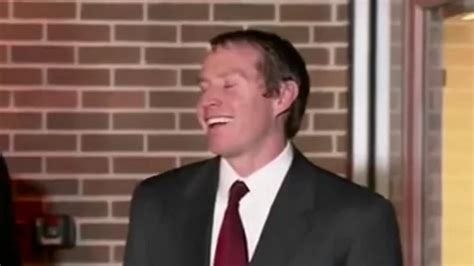
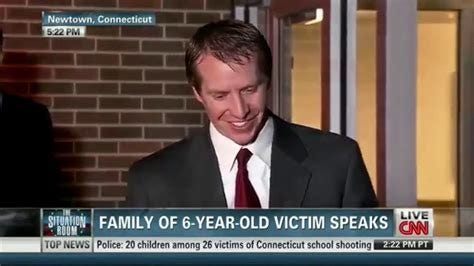
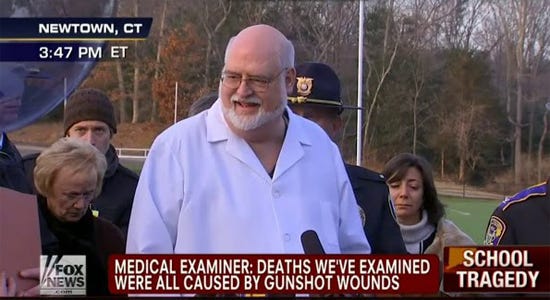



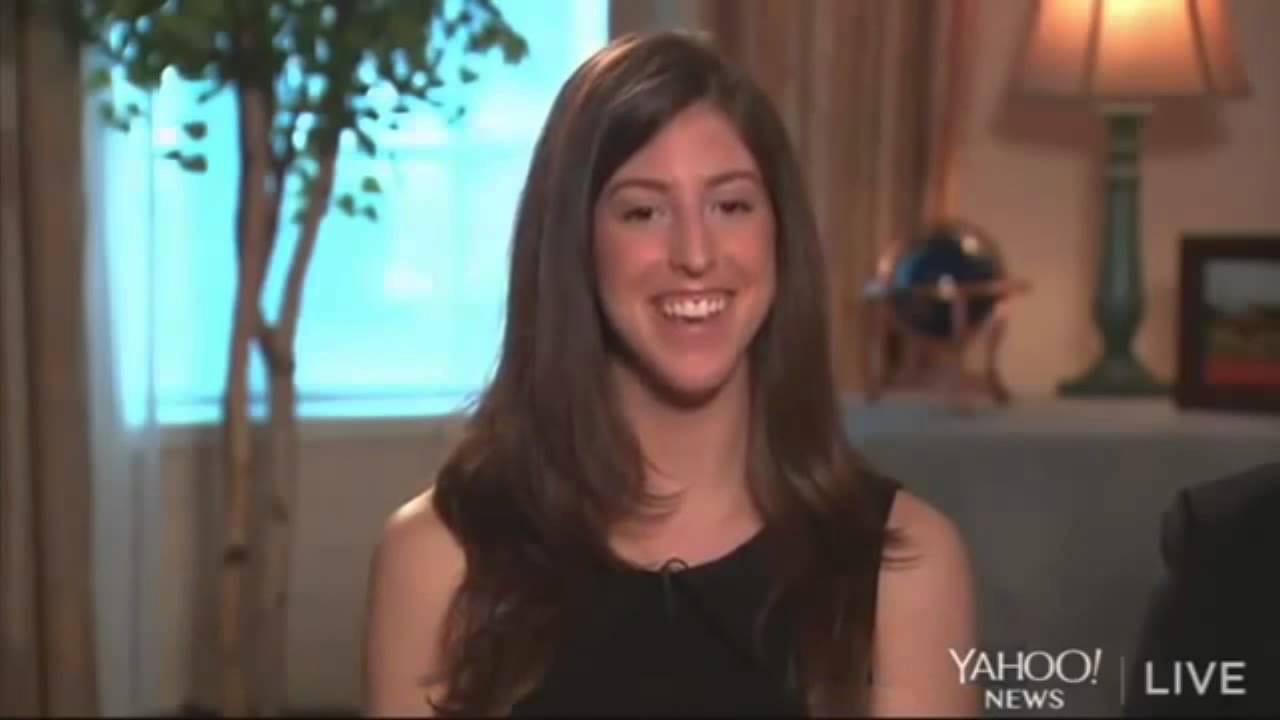

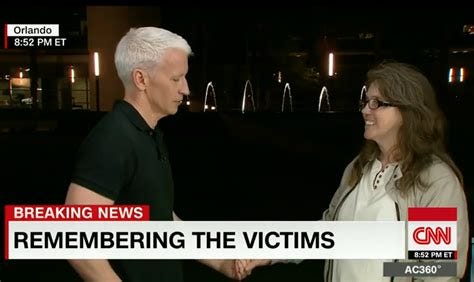



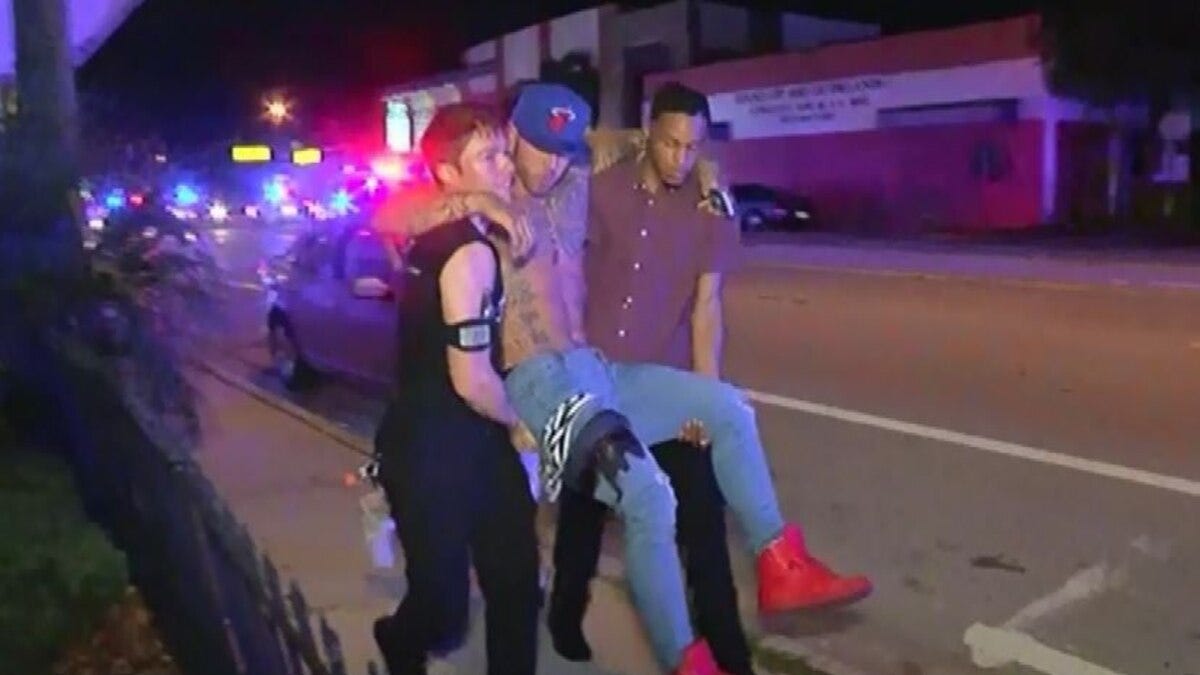

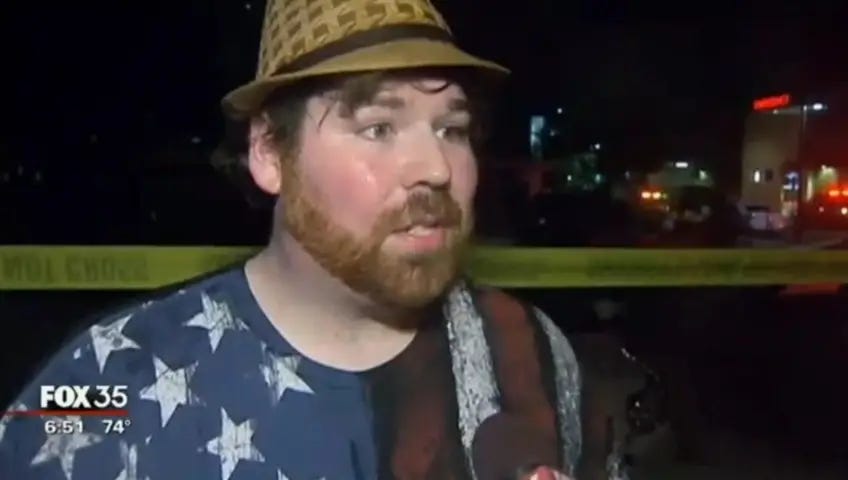

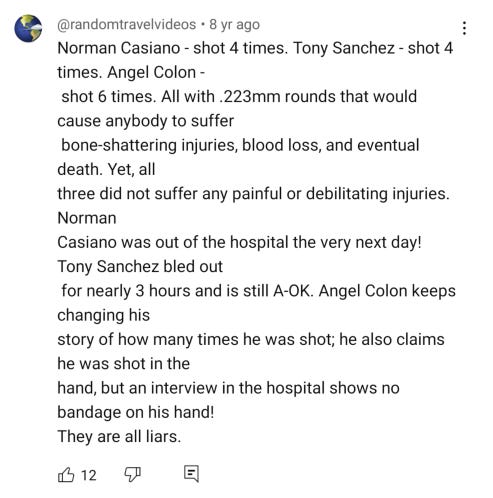
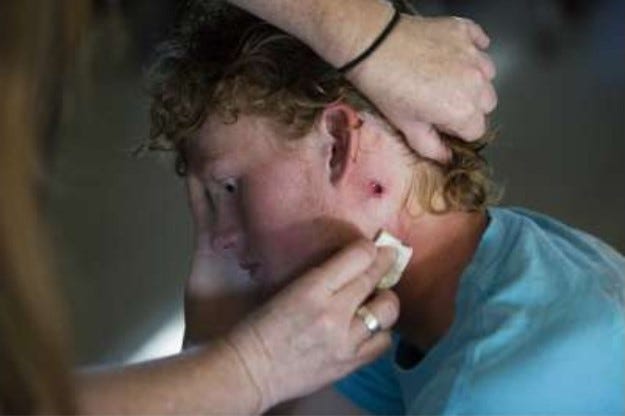


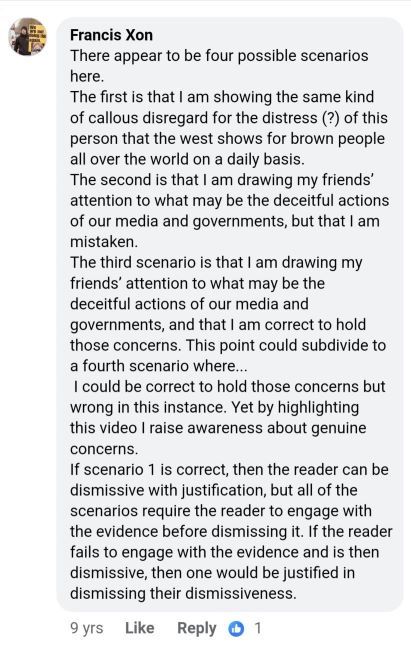

If you've not seen the interview of the Dunblane teacher being interviewed the day after being shot through the head, may I heartily recommend it and the doctors comments at the end.
https://www.youtube.com/watch?v=7pxJj90sIk4
Look up on yt what a .223 round does when it hits a watermelon. No way the wound on that kid's neck was an exit wound from a .223 round. An entrance wound can sometimes look like that, but not an exit wound. The clip of the guy from the Pulse shooting being coached is also pretty wild. I cant quite wrap my head around how they keep all of these people quiet indefinitely, but that doesnt make most of this any less compelling, imo